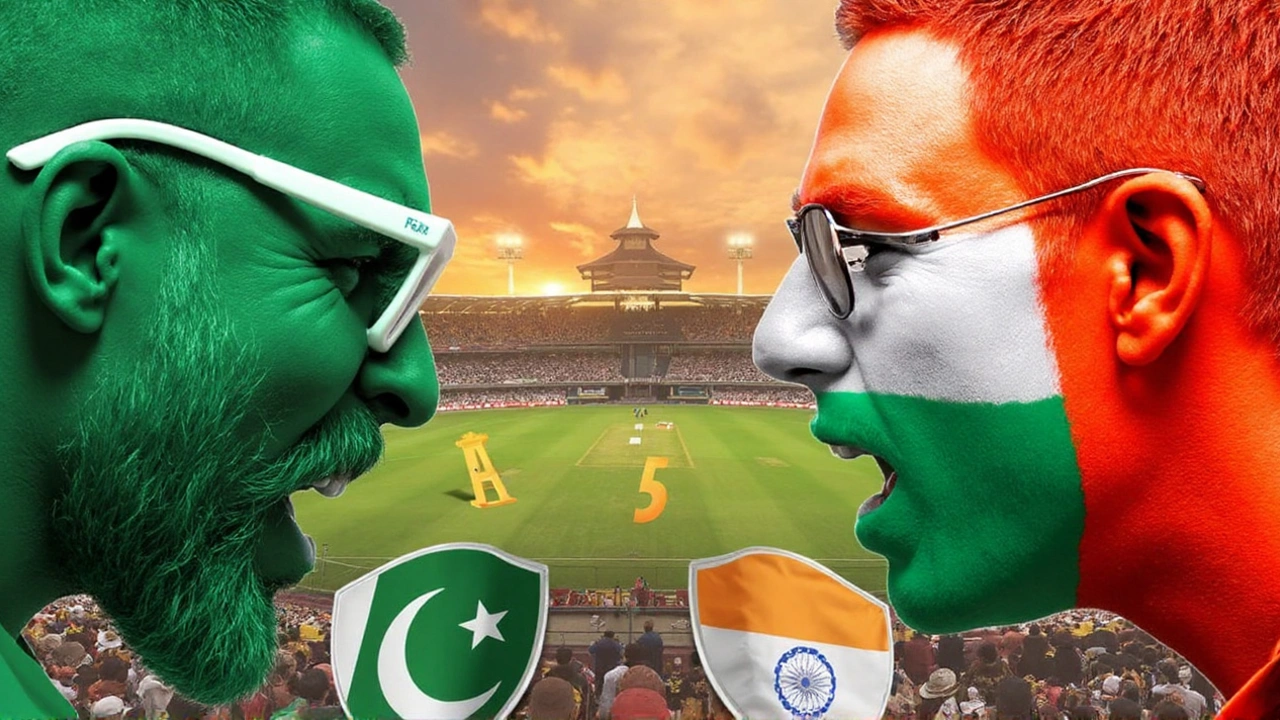India vs Pakistan in the Asia Cup: the numbers
No bilateral games, packed stadiums, and a rivalry that shapes careers—when India and Pakistan meet in the Asia Cup, the stage does the talking. Across the tournament’s history, the balance tilts India’s way. The combined Asia Cup head-to-head stands at 10–6 in India’s favor, with two no-results on record. That count includes both ODI and T20 editions of the tournament.
Format matters here. In ODI Asia Cups, India lead Pakistan 8–5, with two washouts. In the T20 Asia Cup, the split is tighter—India 2, Pakistan 1. If you’ve seen people cite a “bowl-out” tie between the sides, that was from the 2007 T20 World Cup, not the Asia Cup.
India also dominate the trophy cabinet. Since 1984, India have lifted the Asia Cup eight times (1984, 1988, 1990–91, 1995, 2010, 2016, 2018, 2023). Pakistan have two titles (2000 and 2012). That gap says plenty about consistency across eras, formats, and venues.
Most of these games have unfolded at neutral venues—Sharjah, Dubai, Colombo, and Mirpur—because politics keeps bilateral cricket off the calendar. That makes the Asia Cup one of the few windows where form, fitness, and selection gambles are stress‑tested under maximum pressure.
Here’s the format-wise split at a glance:
- Overall Asia Cup meetings (ODI + T20): India 10, Pakistan 6, No result 2
- ODI Asia Cup: India 8, Pakistan 5, No result 2
- T20 Asia Cup: India 2, Pakistan 1
- Asia Cup titles: India 8, Pakistan 2
The rivalry has produced games that live rent-free in fans’ heads. A few examples that define the arc:
- 2012 (ODI, Mirpur): Virat Kohli’s 183 in a chase of 330 remains the gold standard for India in Asia Cup clashes. India won with 13 balls to spare.
- 2014 (ODI, Mirpur): Shahid Afridi finished it with two sixes in the last over against R. Ashwin. Pakistan won by 1 wicket, a classic nail-biter.
- 2016 (T20, Mirpur): A low-scoring slugfest on a green pitch. India chased 84; Virat Kohli’s 49 stood out against high-quality new-ball swing from Mohammad Amir.
- 2018 (ODI, Dubai): India beat Pakistan twice. Shikhar Dhawan (114) and Rohit Sharma (111*) bossed the Super Four game in a 9-wicket win.
- 2022 (T20, Dubai): One-all across two thrillers—India edged the group game; Pakistan hit back in the Super Four. Both went to the last over.
- 2023 (ODI, Colombo): Group game washed out, then India crushed Pakistan by 228 in the Super Four. KL Rahul (111*) and Virat Kohli (122*) stacked a 233-run stand; Kuldeep Yadav took 5.
Individual numbers often get tossed around without context, so let’s keep it clean. Virat Kohli has stacked giant scores against Pakistan in multi-team events—the 183 (2012 Asia Cup) and 122* (2023 Asia Cup) are the bookends. In 2018, India’s top order did the heavy lifting—Dhawan and Rohit flattened Pakistan with two commanding knocks. On the bowling side, Kuldeep’s five-for in 2023 broke the game open, while Bhuvneshwar Kumar has repeatedly struck with the new ball in UAE conditions. For Pakistan, Shoaib Malik’s 143 in the 2004 Asia Cup and Afridi’s 2014 finish are still part of the folklore, and in T20s, Mohammad Amir’s 2016 spell remains the visual many recall first.
One misconception worth clearing up: player tallies you see floating around—like Kohli’s 488 T20I runs against Pakistan or Bhuvneshwar’s T20I wickets—cover all T20 internationals (World Cups and other events), not just the Asia Cup. The Asia Cup slice is smaller, and format-specific splits matter.
So what explains India’s edge? Depth has been the constant. From the 1990s to now, India have usually carried a stronger middle order and more spin options suited to subcontinental surfaces. Pakistan’s pace attacks have been world-class in bursts—and lethal under lights in the Gulf—but batting depth has swung more often India’s way in tournament play.
Conditions have mattered too. Dubai and Colombo often bring in dew, making tosses and new-ball spells crucial. India’s white-ball seamers—Bhuvneshwar, Bumrah, and now the supporting cast—have tended to hit that Test-match length early, then hand it to wrist-spin to choke the middle. Pakistan’s best days against India in the Asia Cup have either come via early inroads with the ball or quick, momentum-changing cameos—think Afridi or, in T20s, the left-right spin/power options used smartly in 2022.
If you’re after the elevator pitch, it’s this: in the Asia Cup, India usually win the middle overs; Pakistan win when the new ball or finishing overs skew their way. That’s the heartbeat of this IND vs PAK head to head chapter.

Recent form, context, and what to expect in 2025
Recent results only sharpen India’s advantage. In 2023, the ODI Super Four game turned into a statement win—228 runs is the biggest margin in the rivalry by distance. Rahul got through an injury comeback with a hundred, Kohli found top gear, and Kuldeep owned the middle. Pakistan were hit by injuries to their pace trio during that game—Naseem Shah’s exit hurt their balance—and the gulf widened fast.
Go a year earlier and you get the contrast. In 2022’s T20 Asia Cup in Dubai, the two sides split the games 1–1, both going to the last over. That’s a reminder: in T20s, the gap is slimmer. Small moments—an over of spin to a left-hander, a dropped chance, a misread yorker—swing the result. In ODIs, the bigger sample of overs tends to reward India’s batting depth and wrist-spin control.
What about 2025? As things stand, the India–Pakistan Asia Cup meeting is pencilled in for Sunday, September 14, subject to the final schedule, format, and venue confirmation by the Asian Cricket Council. Given recent cycles, a T20 edition is likely, but boards have switched formats before to align with ICC events. The venue will be a storyline—neutral hosting and hybrid models have become the default whenever India and Pakistan are in the same draw.
Selection will be another subplot. For India, watch the balance between high-pace powerplay bowling and middle-overs spin. Jasprit Bumrah and a second enforcer at the death change how they attack Pakistan’s top order. Kuldeep Yadav has become the control-and-strike option around overs 15–35 in ODIs and the choke point in T20s. In the batting, Rohit’s powerplay tempo and Virat’s stability are the twin pillars, with the No. 4–6 mix decided by form and fitness—KL Rahul, Shreyas Iyer, Suryakumar Yadav, Rishabh Pant, and Hardik Pandya give flexibility across formats.
Pakistan’s keys are clear too. The top three’s intent against high-class seam decides par scores. Babar Azam’s anchor role is set, but strike rotation against wrist‑spin and new-ball risk management will be in focus. With the ball, the left-arm pace of Shaheen Afridi, plus Naseem Shah and Haris Rauf when fit, remains the template—early swing, a hard length through the middle, then pace-off at the death. In T20s, a floating finisher—often a left-hander who can target matchups—has been their best lever against India.
Conditions could narrow or widen the gap. Dubai under lights with dew makes chasing strong; Colombo brings spinners in mid-innings but can be rain-hit. If a hybrid venue model returns, scheduling back-to-back days (with a reserve day) could keep quicks fresh on one side and tire them on the other—small edges that matter in this rivalry.
Expect narrative pressure too. India haven’t played Pakistan in a bilateral series for over a decade; that makes every Asia Cup meeting feel like a mini-final. The Champions Trophy is set for 2025, and board relations hover over logistics. All of that spills into team prep: neutral wickets, long travel weeks, and a microscope on every XI call.
If you’re mapping the likely script for 2025, pencil in these swing factors:
- Powerplay battles: Shaheen vs Rohit/Virat; Bumrah vs Babar. Early wickets decide whether spin can attack.
- Middle-overs control: Kuldeep’s spell vs Pakistan’s right-handers; Pakistan’s wrist/left-arm spin matchups to India’s middle order.
- Death overs: India’s finishing (Hardik, SKY/Pant) vs Pakistan’s pace variations (Rauf/Naseem). One 18th over can flip a T20.
- Fielding under pressure: Run-out chances and boundary saves have decided recent games more than people think.
The numbers say India hold the edge, especially in ODIs, but T20s keep the door open. Across Asia Cup history, India’s 10–6 lead with two no-results is a fair snapshot of the past—and a reminder that form under tournament pressure is its own skill. With a tentative date on the calendar for September 14, 2025, the next chapter is close enough for teams to plan, but far enough for form, injuries, and venue politics to shuffle the deck. And that’s why, every time the draw comes out, this fixture gets circled first.





